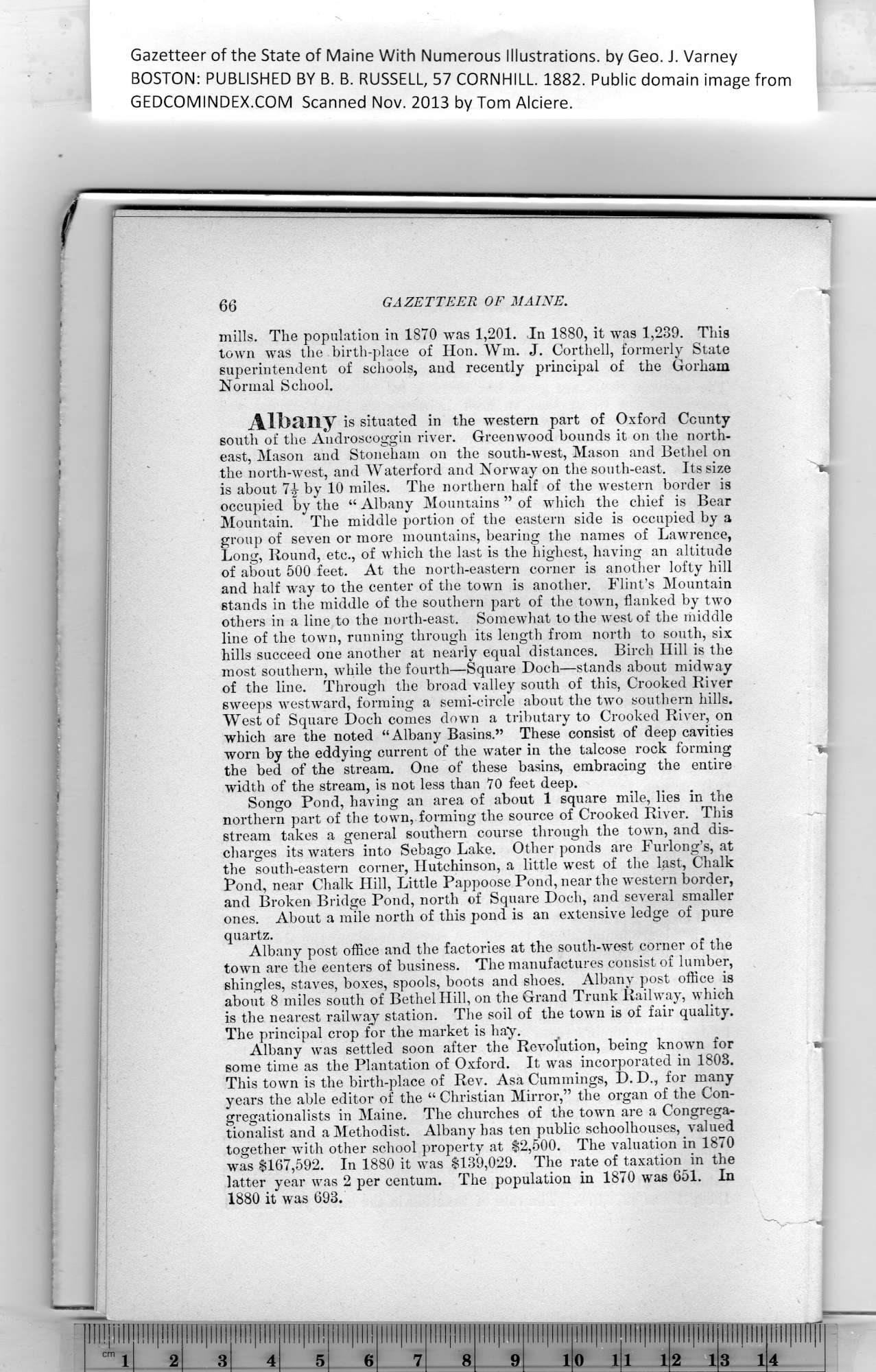|
Gazetteer of the State of Maine With Numerous Illustrations, by Geo. J. Varney
BOSTON: PUBLISHED BY B. B. RUSSELL, 57 CORNHILL. 1882. Public domain image from
66 GAZETTEER OF MAINE.
mills. The population in 1870 was 1,201. <In 1880, it was 1,239. This
town was the birth-place of Hon. Wm. J. Corthell, formerly State
superintendent of schools, and recently principal of the Gorham
Normal School.
Albany is situated in the western part of Oxford County
south of the Androscoggin river. Greenwood bounds it on the north-
east, Mason and Stoneham on the south-west, Mason and Bethel on
the north-west, and Waterford and Norway on the south-east. Its size
is about 74 by 10 miles. The northern half of the western border is
occupied by the “ Albany Mountains ” of which the chief is Bear
Mountain. The middle portion of the eastern side is occupied by a
group of seven or more mountains, bearing the names of Lawrence,
Long, Round, etc., of which the last is the highest, having an altitude
of about 500 feet. At the north-eastern corner is another lofty hill
and half way to the center of the town is another. Flint’s Mountain
stands in the middle of the southern part of the town, flanked by two
others in a line to the north-east. Somewhat to the west of the middle
line of the town, running through its length from north to south, six
hills succeed one another at nearly equal distances. Birch Hill is the
most southern, while the fourth—Square Doch—stands about midway
of the line. Through the broad valley south of this, Crooked River
sweeps westward, forming a semi-circle about the two southern hills.
West of Square Doch comes down a tributary to Crooked River, on
which are the noted “Albany Basins.” These consist of deep cavities
worn by the eddying current of the water in the talcose rock forming t
the bed of the stream. One of these basins, embracing the entire
width of the stream, is not less than 70 feet deep.
Songo Pond, having an area of about 1 square mile, lies in tbe
northern part of the town, forming the source of Crooked River. This
stream takes a general southern course through the town, and dis-
charges its waters into Sebago Lake. Other ponds are Furlong’s, at
the south-eastern corner, Hutchinson, a little west of the last, Chalk
Pond, near Chalk Hill, Little Pappoose Pond, near the western border,
and Broken Bridge Pond, north of Square Doch, and several smaller
ones. About a mile north of this pond is an extensive ledge of pure
quartz.
Albany post office and the factories at the south-west corner of the
town are the centers of business. The manufactures consist of lumber,
shingles, staves, boxes, spools, boots and shoes. Albany post office^ is
about 8 miles south of Bethel Hill, on the Grand Trunk Railway, which
is the nearest railway station. The soil of the town is of fair quality.
The principal crop for the market is hay.
Albany was settled soon after the Revolution, being known for .
some time as the Plantation of Oxford. It was incorporated in 1803.
This town is the birth-place of Rev. Asa Cummings, D. D., for many
years the able editor of the “ Christian Mirror,” the organ of the Con-
gregationalists in Maine. The churches of the town are a Congrega-
tionalist and a Methodist. Albany has ten public schoolhouses, valued
together with other school property at $2,500. The valuation in 1870
was $167,592. In 1880 it was $139,029. The rate of taxational the
latter year was 2 per centum. The population in 1870 was 651. In
1880 it was 693.
PREVIOUS PAGE ... NEXT PAGE
This page was written in HTML using a program written in Python 3.2
|
